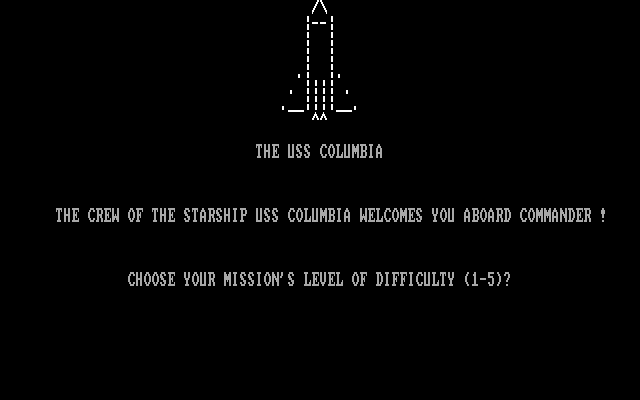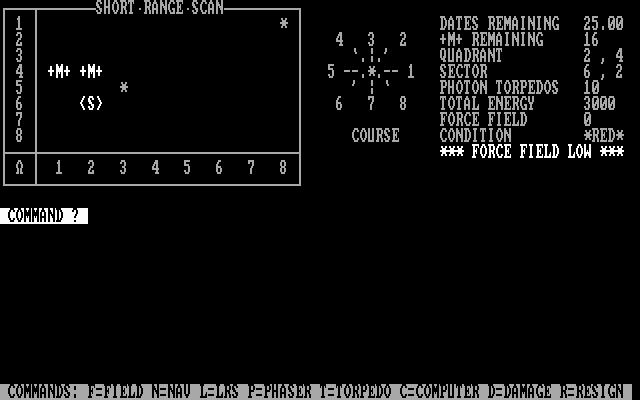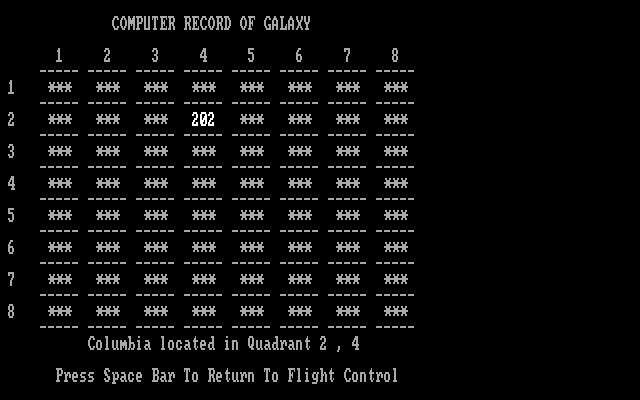Retro Replay Review
Gameplay
Galaxy Trek places you at the helm of the USS Columbia, tasking you with intercepting and destroying a fleet of rogue warships before they can lay waste to Federation Headquarters. The core loop revolves around plotting courses through a grid of quadrants, setting both direction and speed for each jump. This navigational system is simple to grasp but offers surprising strategic depth, as choosing the optimal path can mean the difference between a decisive victory and an untimely defeat.
(HEY YOU!! We hope you enjoy! We try not to run ads. So basically, this is a very expensive hobby running this site. Please consider joining us for updates, forums, and more. Network w/ us to make some cash or friends while retro gaming, and you can win some free retro games for posting. Okay, carry on 👍)
Upon entering a quadrant that harbors enemy vessels, you transition seamlessly into combat. You can engage with either phasers, which consume ship energy, or photon torpedoes, which are limited in supply but pack a heavier punch. Balancing your offensive capabilities against the finite reserves of your shields and weapon systems adds a layer of resource management tension. Knowing when to press the attack, when to retreat to a space station, and when to conserve energy becomes critical as the enemy forces close in.
Adding to the urgency is a strict time limit: you must annihilate all hostile warships before time runs out. This countdown mechanic keeps every decision meaningful, pushing you toward swift, decisive actions. The game’s pacing rarely lets up, offering bursts of high-intensity combat and quick jumps across the star map. Veteran space-tactical gamers will appreciate the minimalist yet challenging design, while newcomers can ease in with a clear objective and straightforward controls.
Graphics
Galaxy Trek embraces a retro aesthetic by rendering its space battles in ASCII graphics. At first glance, the monochrome symbols and simple character-based displays may feel nostalgic rather than cutting-edge, but the minimal visuals are surprisingly effective at conveying tactical information. Enemy ships, stars, and stations each have distinct ASCII representations, ensuring you can quickly parse what’s happening on-screen, even in the heat of battle.
The title supports RGB, Mono, and Composite display modes, catering to a variety of vintage and modern setups. RGB offers the richest palette, coloring your phasers, torpedoes, and navigational grid for vivid clarity. Mono strikes a classic black-and-white balance for that authentic terminal feel, while Composite simulates the fuzzy, analog charm of early home consoles. Each mode lends a different atmosphere, and switching between them can rekindle the excitement of old-school gaming.
While Galaxy Trek won’t win awards for cutting-edge visuals, its ASCII presentation underscores the gameplay rather than overshadowing it. On modern screens, you’ll find the crisp characters easy to read, and on retro hardware, the Composite output injects just enough “glow” to stir nostalgia. For fans of minimalist design, the graphics serve as an effective conduit for the game’s strategic focus.
Story
The narrative premise is straightforward: a rogue fleet of warships threatens to destroy the heart of the Federation. As captain of the USS Columbia, you’re humanity’s best—and perhaps last—hope. While the storyline doesn’t delve into intricate character arcs or political intrigue, it provides clear motivation for your mission and maintains a consistent sense of high stakes throughout your playthrough.
There’s a certain charm in its simplicity: you know precisely why you’re here, what you need to do, and the ticking clock keeps you on edge. Occasional mission updates inform you of enemy reinforcements or the condition of Federation Headquarters, but the emphasis remains firmly on tactical execution rather than narrative complexity. This stripped-down approach ensures that players stay focused on outmaneuvering opponents rather than wading through cutscenes or lengthy exposition.
Though fans of deep lore may feel the story is more framework than feature, the urgency of defending the Federation and the clear “destroy or be destroyed” premise drive you forward. Galaxy Trek’s story succeeds by marrying a simple plot to intense gameplay, letting you fill in the narrative gaps with your own spacefaring heroics.
Overall Experience
Galaxy Trek offers a compact but compelling space-battle experience that distills starship combat into its purest form. Its minimalist graphics and straightforward premise may seem modest at first, but the game’s tight controls, resource management challenges, and relentless countdown fuse into an unexpectedly addictive package. Whether you’re charting strategic jumps across the quadrant map or weaving in and out of enemy fire, every moment feels purposeful.
The game’s learning curve is gentle enough for newcomers to space sims, yet rewarding for veterans who appreciate its nod to classic ASCII-driven titles. The ability to toggle between RGB, Mono, and Composite modes adds replay value and gives you a taste of retro gaming aesthetics. Resource scarcity, combined with a strict time limit, keeps the pressure dialed up throughout, encouraging multiple attempts to refine your tactics.
Ultimately, if you enjoy streamlined strategy, old-school visuals, and high-stakes combat, Galaxy Trek delivers a satisfying ride. It may lack the bells and whistles of modern AAA space titles, but it makes up for that with laser-focused gameplay and a palpable sense of urgency. For players seeking an affordable, nostalgia-tinged challenge that rewards careful planning and quick reflexes, the USS Columbia awaits.
 Retro Replay Retro Replay gaming reviews, news, emulation, geek stuff and more!
Retro Replay Retro Replay gaming reviews, news, emulation, geek stuff and more!








Reviews
There are no reviews yet.